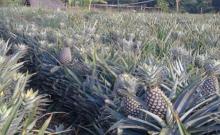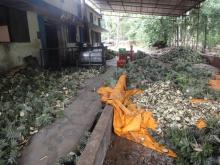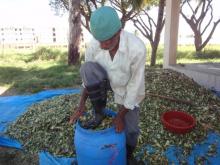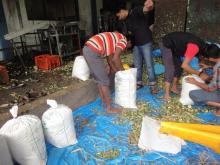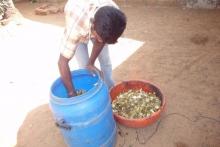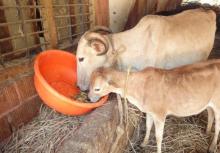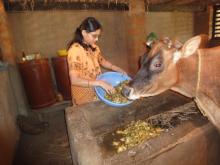Pineapple fruit residue silage as fodder source for livestock
By N.K.S. Gowda, S. Anandan and D. T. Pal, ICAR- National Institute of Animal Nutrition and Physiology, Bangalore 560 030, India
Pineapple (Ananas comosus) is a commercial horticultural crop grown in some parts of India, East Asia and Africa. The fruit is processed for juice, jam and canned products for human consumption. Out of the whole fruit, only about 30% is edible and remaining 70% (crown, peels, pulp) is non-edible for human consumption. In India this crop is grown in about 90 000 hectares of land and 30–35% is processed in industries and more than 1.3 million ton of this non-edible residue is available annually and is being wasted. The pineapple fruit residue (PFR) contains high moisture (65–70%) and total sugar (>50%) making it susceptible for fungal growth and spoilage within 2 days.
A study was undertaken at National Institute of Animal Nutrition and Physiology (NIANP), Bangalore to improve the keeping quality of PFR through silage technology. The PFR was chaffed into pieces of 1–2 inches and compacted in plastic drums/bags of 50 kg capacity at a moisture content of about 65% with 4:1 ratio (w/w) of pineapple leafy crown and fruit peels, and kept under airtight condition (see video for the process of silage preparation). In a period of 20 days, good quality silage was prepared with average pH and lactic acid content of 4.2 and 6–7%, respectively. Nutritive value of the PFR silage on dry matter basis (total sugars 52.0%, crude protein 7.50%, neutral detergent fibre 56.04%, acid detergent fibre 19.76%, total digestible nutrients 72%, calcium 0.61%, and phosphorus 0.30%) was better than the conventional maize green fodder. Evaluation and validation was done through feeding studies in sheep and dairy cows using PFR silage as fodder source. The ration was balanced for major nutrients with PFR silage and concentrate mixture, and fed as total mixed ration (TMR).
Feeding of PFR silage based TMR to sheep for 75 days did not show any adverse effects and supported a daily growth rate of 140 g, and the overall performance was similar to maize green fodder silage based TMR fed group of sheep (Control). Study in dairy cows fed PFR silage based TMR replacing conventional hybrid Napier green fodder for 90 days showed an improvement of daily milk yield by about 20% and fat content by 0.6 units. No evidence of metabolic or health related disorders were noticed indicating that PFR silage was effectively utilized by the livestock. A technical workshop was conducted at Sirsi, Karnataka, India to popularise this technology. Now the dairy farmers have started obtaining the fruit residue from the nearby factories and make silage for feeding to dairy animals. Its feeding has been found very economical. Currently, the cost of PFR silage is half the price of conventional green fodder. A fruit processing factory located in this region (M/s. Fresh Fruits Processing Pvt. Ltd.) has taken the technology from NIANP to prepare silage from pineapple fruit residue in drums and bags and market as fodder for livestock. This technology has a potential for adoption in Kerala, North-eastern parts of India and parts of East Asia and Africa where pineapple fruit is cultivated and processed.
Pineapple fruit crop
Pineapple fruit residue in processing unit
Silage preparation from pineapple fruit residue in drum and bag
Livestock feeding on pineapple fruit residue silage as fodder source
Further reading
- Gowda, N.K.S., N.C. Vallesha, V.B. Awachat, S. Anandan, D.T. Pal and C.S. Prasad. 2015. Study on evaluation of silage from pineapple (Ananas comosus) fruit residue as livestock feed. Tropical Animal Health and Production 47: 557–561 DOI: 10.1007/s11250-015-0762-2.
- Upadhyay, A., J.P. Lamba and S. Tawata. 2010. Utilization of pineapple waste: a review. Journal of Food Science and Technology of Nepal 6: 10–17 DOI: 10.3126/jfstn.v6i0.8255


